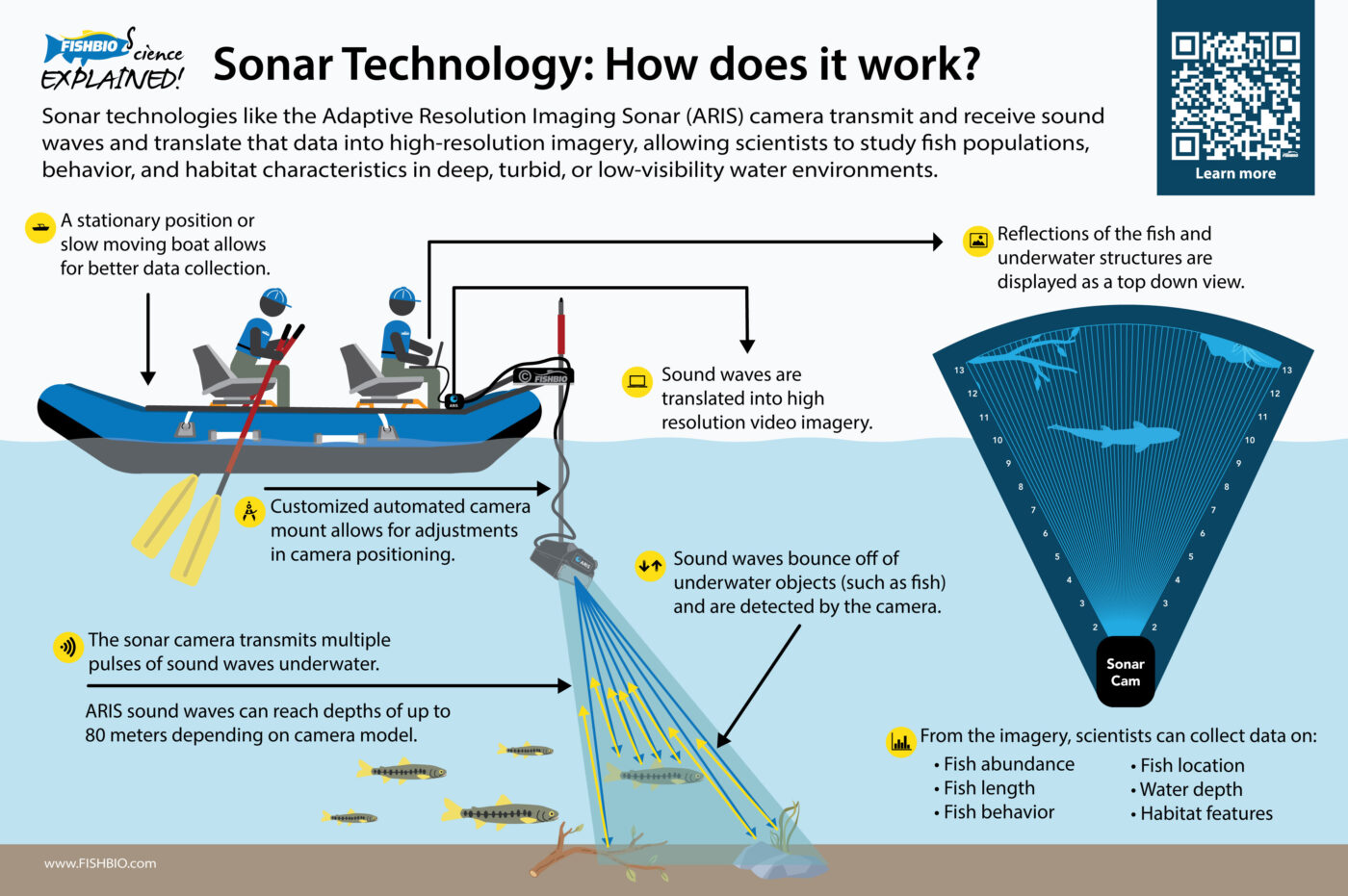Monday August 12, 2024

An oft quoted fisheries biologist once said “counting fish is like counting trees, except they’re invisible and they move around.” While this idiom is always sure to get a laugh and a knowing nod from fellow biologists, there are technologies available that can help researchers overcome these challenges and “see” underwater. Such tools include sonar cameras that convert pulses of sound reflected off of underwater objects into high resolution digital imagery, similar to a medical ultrasound. This technology allows biologists to make real-time observations of fish in their natural environment without ever having to enter the water. What’s more, sonar can see through very muddy water where visual observation would be impossible. These characteristics make sonar a valuable tool to count and measure fish, observe fish behavior, and visually assess aquatic habitat – all from the deck of a boat.
Adaptive Resolution Imaging Sonar (ARIS) is based on Dual-frequency Imaging Sonar (DIDSON) technology, which was originally developed by Sound Metrics for military use but is now commonly utilized by fisheries biologists for a variety of purposes. Although there are several different models of these sonar “cameras,” the core technology is the same. Multiple pulses of sound waves are emitted from the ARIS at a given frequency, the sound waves then bounce off of underwater objects and reflect back to the unit. Built-in software then transforms the detected sound waves into near-video quality imagery capable of portraying details as small as a few millimeters in size. Because this technology relies on sound waves – which have a much longer wavelength than light waves – the ARIS can be used to observe fish and their habitats at distances of up to 80 meters, even in dark or turbid environments that a traditional video camera could never penetrate. Sound waves can also go around suspended particles or other obstructions that might block light waves. In addition, the software provides instant quantifiable data on fish length, depth, and range from the camera. The unit usually comes with a variety of lens accessories as well, making it possible to fine tune the range and focus of the camera

The ARIS unit on a riverbank.
In order to collect the most accurate data, the ARIS unit should be mounted in a stationary position or on slow moving vessels. ARIS units have been mounted on a variety of housings, with some researchers integrating additional data collection devices onto mount designs. FISHBIO’s custom fabricated mount, which is mainly used for freshwater fish data collection, allows for precise underwater positioning of the camera. The mount is equipped with operational controls, enabling researchers to manage the mount and review captured data simultaneously. This means only two staff are needed, one to operate the boat and one to collect ARIS data.
After performing a survey, all footage must be reviewed to record any observations of fish or other species of interest. Thankfully, playback speeds can be altered to reduce the amount of time spent on video review and various filters can be added to the imagery to help make fish more easily visible. In addition, the software creates what is called an echogram for each data file. These echograms are displayed in the form of a graph and depict any fish tracks and objects observed in the recording, as well as their relative size and distance from the camera. There is also third party software available that can further automate the video review process and provide tabulated data for each file reviewed.

Deploying the ARIS to observe fish in deep pools in the Mekong River.
From upstream reaches of California’s rivers all the way downstream to the San Francisco Bay, and even in the Mekong Basin of Southeast Asia, FISHBIO has used the ARIS to great effect in a wide variety of fish research and monitoring projects. In the Sacramento-San Joaquin Delta, the ARIS was deployed during boat electrofishing surveys to determine if the sonar camera could be used to identify and count nonnative predatory fish – a task that was ultimately accomplished with the help of advanced modeling tools.
The ARIS was also deployed to monitor two different tidal marsh restoration projects in the San Francisco Estuary, which were designed to determine how the fish community responds to habitat restoration as well as how well ARIS observations compare to fish counts from traditional gear like seine nets. On the other side of the globe in Laos and Cambodia, FISHBIO piloted the utility of the ARIS for observing fish in deep pools and popular fishing areas in the Mekong River.
ARIS footage of oyster beds at an oyster restoration site.
Of course, all of these exciting applications would not be possible without the creative and customized camera mounts created by FISHBIO’s FABLAB, which allow for control of the depth, pan, tilt, and roll of the camera, whether mounted on shore or on a boat. This functionality has greatly improved the utility of the ARIS and ensures a clear view underwater in almost any environment imaginable. With the help of sound waves, biologists can make all those “invisible” fish hiding beneath the waves a little more visible, and a little easier to monitor and study.
Header image: A graphic depicting how sonar cameras function.
This post was featured in our weekly e-newsletter, the Fish Report. You can subscribe to the Fish Report here.
